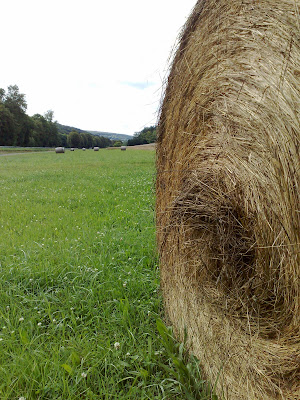2009-07-28
Rustic Lorraine
The pleasant valley of the River Blies, where it forms the border between Germany and France. This is the southern, French side.
I am sure hay bails used to be box shaped. I wonder what further advances in hay technology await us in the 21st century.
Subscribe to:
Post Comments (Atom)

j'aime beaucoup le cadrage....belle photo champêtre...
ReplyDeletehave a nice day..:)
I love this shot ... but then again I adore hay bales. I especially like the way you have captured the details of the spikey bits in the centre of the roll.
ReplyDeleteI agree they were once box shaped and it was more than 15 years ago when they started to roll in Australia. Though I am no expert on rural matters, just a happy observer.
Ironically, I was just discussing hay bales yesterday with a friend. In my youth, I helped bale hay at my grandpa's farm in Wisconsin - big, heavy rectangular bails. It was hard work, but the memories are good ones for me.
ReplyDeleteGreat photo!
mmm, hay bail: a new thing for me. What it's use for?
ReplyDeleteIn my part of world, I often seems hay at paddy field, but not like this one. Please tell me more:)
I like the way you captured the hay bail. Looks like a huge snail passing by.
ReplyDeleteFantastic composition! Love it!
ReplyDeleteBy the way, como é que um inglês que vive na Alemanha sabe escrever português tão correctamente? :-))
Thanks for the comments.
ReplyDeleteclo: Merci.
Joan Elizabeth: As is often the case, this blog post made me look up the subject matter in Wikipedia and I have become slightly the wiser. The reason for the switch to round hay bails is twofold. They are easier to roll around the field, although you need a machine to lift them out of the field, and, more importantly, since they are big and dense, they can be left in the field. The weather will spoil the hay, but with a big round bail you can throw away the outer part and still have good feed.
RogerB: I used to spend the long summer holiday's of my childhood on my uncle's farm. I, too, have good memories. Wikipedia mentions that the switch to round bales was, in part, to avoid the back-breaking carrying of the square ones. However, the round ones are not without dangers: “From 1992 to 1998, 74 farm workers in the United States were killed in large round hay bale accidents, usually when bales were being moved from one location to another, such as when feeding livestock”.
ical: It is mostly used to feed the animals on the farm in the winter. I guess the lucky cows in Indonesia can eat grass outside all year long.
Buenos Aires Photoblog: You should have seen the size of its slime trail!
JM: Com ajuda grande de priberam.pt. A verdade é que quase não sei português. Sei espanhol porque a mia esposa é de Almería e escuto muita música brasileira (e de Mariza).
Tudo isto só com ajuda do priberam e da Mariza? Fantástico! :-) Obrigado pelo esclarecimento.
ReplyDeleteI've seen both types of bales around Switzerland: the round and the rectangular. More of the round ones though, probably because of the reasons you mention. Many of them get covered with plastic.
ReplyDeleteIn case you'd like to see my examples of all of these, poke around this old post of mine (links to the other two types from there).
Z: Thanks for the link. Wikipedia mentions the plastic covers. I guess it easier to put plastic covers around big round bails than put put little covers around square bails or take the square bails into a barn.
ReplyDelete